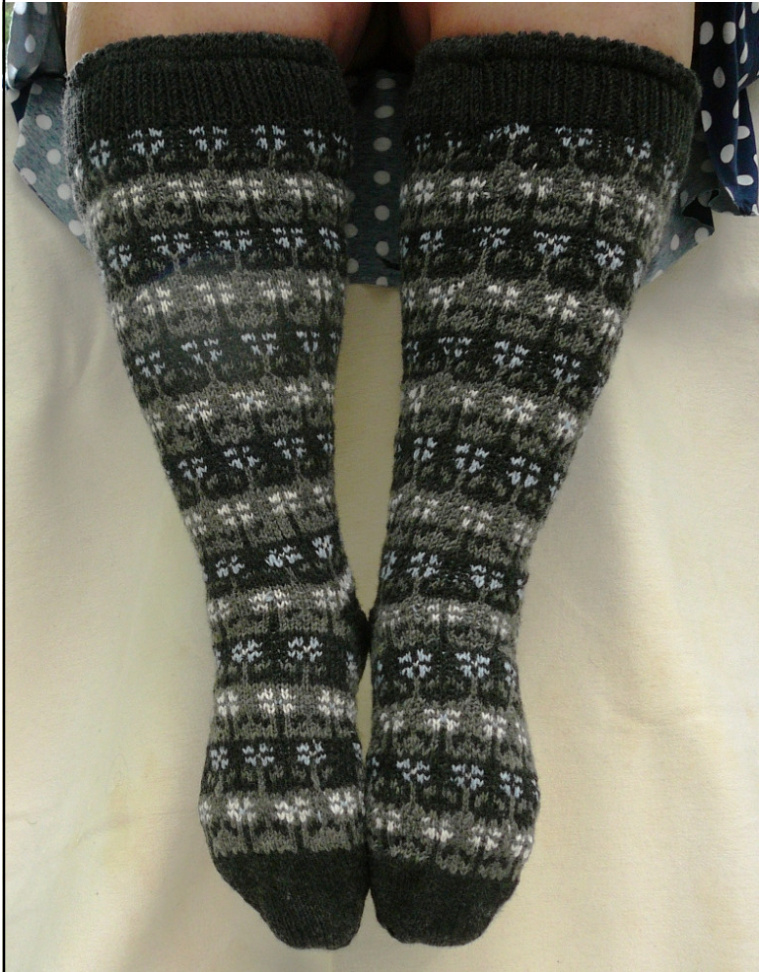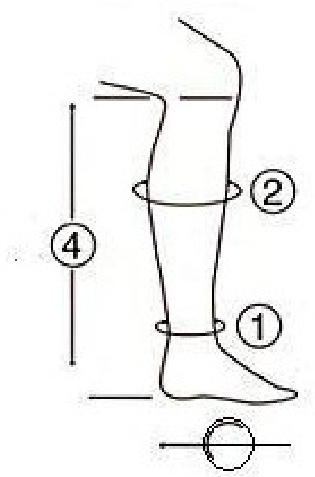,Frost flowers" knee-highs stockings

Size: (M EU 40) advice for adaptions are given Yarn: 6ply sockyarn or similar sport weight yarn Yarn used: Lana Grossa Cool Wool Merino Superfein for one pair of knee-highs use 3 balls MC 1 (dark grey), 2 balls MC 2 (light grey), 1 ball CC 1 (iceblue), 1 ball CC 2 (white) Size needle: 3,5 mm (US size 4) and 4 mm (US size 6) circulars or dpn also needed: stitch markers contrasting waste yarn tapestry needle elastic (optional) to adapt size: cast-on less/more stitches knit shorter/longer foot add/detract increase rounds (total stitch number must be divisible by 8) The Frost Flowers knee-high stockings are perfect for showing off in boots on those clear frosty-cold winter days. The pretty flowers grow organically out of the previous stripe. Although four (or more?) colors are used, each round only contains two colors at a time, perfect for holding one color in each hand. The stockings are knit toe-up which allows for frequent try-ons. I used cicular needles in the magic-loop technique, but feel free to use dpns if you feel more comfortable. The pattern assumes you have knit a sock before. For questions about actual The pattern features stranded knitting, an afterthought heel and calf-shaping, I chose to increase to both sides of a central ,seam" at the back of the calf, but increases could be placed wherever best fit is achieved—even several increases per stripe. For best fit measure your own legs and adapt pattern accordingly (see advice on last page). Pattern includes colored charts for easy reference, but the 8-stitch repeat is easily memorized. The picot edge atop the ribbed cuff allows to insert an elastic for better fit (optional). Please read complete pattern before starting. Advice on adjustments and finding tutorials for unfamiliar techniques is given On last page.
Note:
The pattern is free to download, knit and share. You can knit as many socks as you like and keep them or give them away to family, friends, strangers or charity. You are not allowed to sell the pattern or the finished socks unless you want to donate the moneyreceived to charity. Also, Iam not a native speaker of English. If you find my wording strange or my grammar incorrect, or if you find a mistake, please contact me. Thank you! List of used abbreviations:
| MC CC | main color contrastcolor | pm slm | place marker slip marker | sl1wyb k2tog | slip1 with yarn in back knit two together |
| st | stitch | m1L | make one left | ssk | slip, slip, knit together through back loop |
| sts | stitches | m1R | make one right | yo | yarnover |
Frost Flowers knee-high stockings—knitting instructions
Toe:
With smaller needle size (3,5mm/US 4) and MC 1 (dark grey), cast-on 24 sts, using your favorite toe-up cast-on.(1 prefer the Turkish cast-on). Knit toe, finishing increases after 20 rounds with 64 sts (or stitch number divisible by 8). Change to larger needles (4mm/US 6).
Foot:
Take up second color (MC 2, light grey). From now on, knitting is stranded with two colors per round. Beginning of round is at side of toe. (I prefer background color in my right hand) First stripe: beginning with MC 2, knit 8 repeats of chart 1. Next stripe: knit 8 repeats of chart 2 beginning with 4th stitch (=flower stem in previous MC: new stems ,grow" from background color stitch column between previous flowers).
Preparing for afterthought heel:
After five complete stripes (=55 rounds) of foot pattern (or appropriate length, heel will be 6 cm/2,5 inch deep) knit 1 row of 32 sts (= all sole stitches) with waste yarn. Then go back to beginning of row and knit one more complete round in single color (=repeat round 11 of last chart) (Picking up heel stitches later is easiest when waste yarn is framed by one color/strand of yarn only.) Continue knitting in rounds and in established pattern sequence over all stitches—former sole stitches are now at back of calf. Knit at least one more stripe without increases for ankle. Note: If you have measured your legs well and do not require any try-ons for fitting, you can knit just ahead—- otherwise, this would be a good place to knit/finish the afterthought heel.
Leg/calf increases:
Continue in pattern on all needles. In second stripe after heel, mark center back stitch with stitch markers to both sides—-it should be either a ,flower stem" or a single color ,pattern spacer column" stitch. Increases will be placed in background color to the inside of markers (e.g.: slm, m1R, knit chart 3, m1L, slm). Place your increase intervalls according to your measurements. Knit in pattern for 9 stripes (or according to your desired leg length)
Cuff:
R18: \*k2tog, yo\*. This will be the folding line for the picot edge. R24: Turning picot hem inside, sew allive stitches to first row of purl bumps after ribbing. If desired, insert elastic before closing seam completely. Take care not to measure elastic too tightly or to twist it, or to make a too bulky a knot. Start all over for second stocking. Enjoy warm feet all winter long! Tip: Turn your work inside out, always knitting the back needle, so that floats do not tighten up your knitting. Weave floats in frequently, which is easier when holding yarn in both hands and background color in right hand. Colors not in use can be loosely carried up (downside: four balls of yarn to disentangle) or cut and woven in (downside: lots of ends to weave in. If you do it frequently during knitting, it is not too bad, though...)
| sed for the heel. Thus, if you prefer another toe or heel-shaping, feel free to use it! Toe:increaseround:(k1,m1L,knit tolast stitch onneedle,m1R,k1)x2=+4sts | |||||||||||||||||||
| Heel:decreaseround:(k1,ssk,knit tolast stitchonneedle,k2tog,k1)x2=-4sts | |||||||||||||||||||
| Toe: cast-on with Turkish cast-on 2x12 sts (24 sts) | using smaller needle size (3,5mm/US 4) and MC 1 (dark | dpns in smaller needle size (3,5mm/US 4), | |||||||||||||||||
| R1,R2,R3:increaserounds(28,32,36sts) | R1,R2: knit all (64 sts) | ||||||||||||||||||
| R4: knit all | R3: decrease round (60 sts) | ||||||||||||||||||
| R5,R6:increase rounds (40,44 sts) | R4, R5: knit all | ||||||||||||||||||
| R7:knit all | R6: decrease round (56 sts) | ||||||||||||||||||
| R8/10/12:increaserounds(48,52,56sts) | R7/9/11: knit all | ||||||||||||||||||
| R9/11/13/14: knit all | R8/10/12/13: decrease rounds (52/48/44/40 sts) | ||||||||||||||||||
| R15:increase round (60 sts) | R14: knit all | ||||||||||||||||||
| R16/17: knit all | R15/16/17: decrease rounds (36/32/28 sts) | ||||||||||||||||||
| R18:increaseround(64sts) | R18: knit all | ||||||||||||||||||
| R19: knit all R19: decrease round (24 sts) | |||||||||||||||||||
| R20 knit all, change to bigger needles (4mm/ US 6) R 20 : graft together, chanting: knit, slip, purl, purl, slip, knit Take up second color, either in free hand or using preferred Take up knitting leg again, continuing with bigger needles | |||||||||||||||||||
| technique for stranded knitting (4mm/ US 6) | |||||||||||||||||||
| 11 | 11 | ||||||||||||||||||
| 10 | 10 9 | 1+ | |||||||||||||||||
| 9 | 1+ | 1+ | |||||||||||||||||
| 8 7 | 1+ | ||||||||||||||||||
| -! | 1+ | ||||||||||||||||||
| 6 | |||||||||||||||||||
| 5 4 | 4 | ||||||||||||||||||
| 2 1 | 1 | ||||||||||||||||||
| 876543211 87654321 Chart 1: first stripe Chart 2:second stripe Chart 3: Increases worked along center of previous flower | |||||||||||||||||||
Some available online tutorials for techniques mentioned:
Turkish cast-on:
http://fluffyknitterdeb.blogspot.de/2005/10/knitting-made-easier-turkish-cast-on.html http:/projekteprojekte.blogspot.de/2013/06/hacke-spitze-hacke-spitze-ein-tutorial.html (in German)
Afterthought heel:
http://www.socknitters.com/lessons/afterthoughtheels.htm http://projekteprojekte.blogspot.de/2013/08/eisblumen-afterthought-heel.html (in German)
Sewn bind-off
http://projekteprojekte.blogspot.de/2013/07/wip-eisblumen-und-ein-tutorial-fur.html (in German, but with lots of pictures) Stranded knitting with yarn in both hands http://explaiknit.typepad.com/let_me_explaiknit/2006/08/stranded.html For all of these techniques, there are lots of videos and written tutorials out there—keep looking or asking until you find one that works for you. For a good fit, you should compare and adapt the pattern to your own measurements——-this is not difficult. First of all: swatch your gauge. Second: measure your foot and leg, like so:http://appleleeffarm.com/PDFs/cstmsck1.pdf

1: width of ankle (slimmest point) 2. width of calf (widest point) measure distance between 1 and 2 3. length of complete foot (see table)) 4. length of leg (from end of heel to cuff) Feel free to include more measuring points to map your leg more precisely For adapting foot length, remember excluding toe and heel in length (each ca 6 cm/2,5 inch)
| sport weight/ 6ply sock yarn | S | M | L | ||||||
| Size EU | 39 | 40 | 41 | 42 | 43 | 44 | 45 | 46% | 47 |
| Size GB | 9 | 6% | 7 | 7 | 8 | 9 | 10 | 11 | 12 |
| Size US/CA M | 7 | 7% | 8 | 8% | 6 | 10% | 11 | 12 | 13 |
| Size US/CA F | 8 | 9 | 9 | 10 | 10 | 12 | 13 | 14 | |
| cast on stitches | 2x10 | 2x12 | 2x12 | 2x12 | 2x12 | 2x12 | 2x12 | 2x12 | 2x14 |
| stitches for foot | 60 | 64 | 64 | 64 | 64 | 68 | 68 | 68 | 72 |
| short row heel stitches | 7/8/7 | 8/8/8 | 8/8/8 | 8/8/8 | 8/8/8 | 8/10/8 | 8/10/8 | 8/10/8 | 8/10/8 |
| complete foot length (cm) | 25,5 | 26 | 26,5 | 27 | 27,5 | 28 | 28,5 | 29,5 | 30 |
| complete foot length (inch) | 9 7/8 | 10 | 10 1/8 | 10 % | 10 % | 10 %4 | 11 | 111/8 | 11 % |
Because of the 8sts repeat, and because stranded knitting tends to be tight-fitting, aim at 64 foot sts for sizes S and M, and 72 foot sts for size L. Measure foot length and experiment with needle size for preferred fit.









